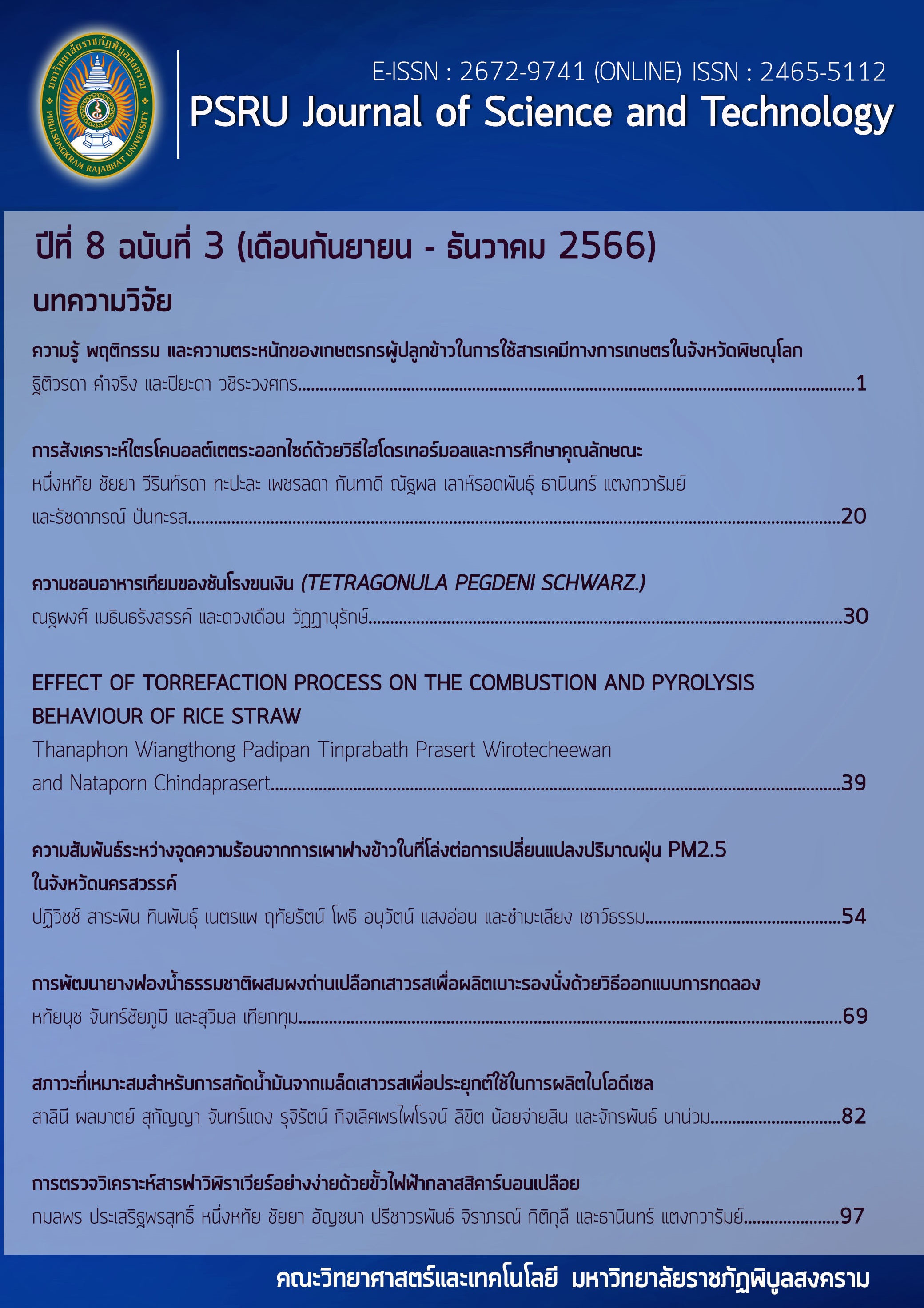THE SIMPLE DETERMINATION OF FAVIPIRAVIR USING BARE GLASSY CARBON ELECTRODE
Keywords:
Glassy carbon electrode, Cyclic voltammetry, Amperometry, Favipiravir sensorsAbstract
The determination of favipiravir for antiviral COVID-19 using a bare glassy carbon electrode was successfully operated by the electrooxidation reaction of the favipiravir. The reaction process was recorded by cyclic voltammetry while the amperometric technique was used for favipiravir quantitation. Analytical parameters such as applied potential, supporting electrolytes, and pH were varied. The optimum condition was found to be +1.30 V, Na2B4O7 – NaOH buffer, and pH 10.20, respectively. The electrochemical sensor was characteristic studied and it showed a linear range of 0.25 µM to 500.0 µM (y (µA)=0.0326x(µM) + 0.1547) with a limit of detection of 0.13 µM favipiravir (S/N=3). This technique exhibited high repeatability at 4.64 %RSD and the interference such as NaCl was unaffected. It was successful in analyzing favipiravir in real samples with high accuracy as the relative error was lower than 1.96 percent. From the results of the research, this sensor can be used to measure the amount of favipiravir in tablet samples to benefit consumers
References
เกาะติดสถานการณ์โควิด. (2566). สืบค้นเมื่อ 27 มิถุนายน 2566, จาก https://www.pptvhd36.com/special/ไวรัสโคโรนา.
Allahverdiyeva, S., Yunusoglu, O., Yardim, Y., & Senturk, Z. (2021). First electrochemical evaluation of favipiravir used as an antiviral option in the treatment of COVID-19: A study of its enhanced voltammetric determination in cationic surfactant media using a boron-doped diamond electrode. Analytica Chimica Acta, 1159, 338418.
Bulduk, İ. (2021). HPLC-UV method for quantification of favipiravir in pharmaceutical formulations. Acta Chromatographica, 33(3), 209-215.
Du, Y.X., & Chen, X.P. (2020). Favipiravir: Pharmacokinetics and concerns about clinical trials for 2019-nCoV infection. Clinical Pharmacology and Therapeutics, 108(2), 242-247.
Erk, N., Mehmandoust, M., & Soylak, M. (2022). Electrochemical sensing of favipiravir with an innovative water-dispersible molecularly imprinted polymer based on the bimetallic metal-organic framework: comparison of morphological effects. Biosensors (Basel), 12(9). https://doi.org/10.3390/bios
Ersan, T., Dilgin, D. G., Kumrulu, E., Kumrulu, U., & Dilgin, Y. (2022). Voltammetric determination of favipiravir used as an antiviral drug for the treatment of covid-19 at pencil graphite electrode. Electroanalysis. https://doi.org/10.1002/elan.202200295.
Kanbeş Dindar, Ç., Bozal-Palabiyik, B., & Uslu, B. (2022). Development of a diamond nanoparticles-based nanosensor for detection and determination of antiviral drug favipiravir. Electroanalysis, 34(7), 1174-1186.
Mehmandoust, M., Khoshnavaz, Y., Tuzen, M., & Erk, N. (2021). Voltammetric sensor based on bimetallic nanocomposite for determination of favipiravir as an antiviral drug. Microchimica Acta, 188(12), 434.
Mikhail, I.E., Elmansi, H., Belal, F., & Ehab Ibrahim, A. (2021). Green micellar solvent-free HPLC and spectrofluorimetric determination of favipiravir as one of COVID-19 antiviral regimens. Microchemical Journal, 165, 106189.
Mohamed, M.A., Eldin, G.M.G., Ismail, S.M., Zine, N., Elaissari, A., Jaffrezic-Renault, N., & Errachid, A. (2021). Innovative electrochemical sensor for the precise determination of the new antiviral COVID-19 treatment Favipiravir in the presence of coadministered drugs. Journal of Electroanalytical Chemistry, 895, 115422.
Wang, S., Wang, C., Xin, Y., Li, Q., & Liu, W. (2022). Core–shell nanocomposite of flower-like molybdenum disulfide nanospheres and molecularly imprinted polymers for electrochemical detection of anti COVID-19 drug favipiravir in biological samples. Microchimica Acta, 189(3), 125.
Downloads
Published
Versions
- 2024-05-29 (2)
- 2023-12-20 (1)
How to Cite
Issue
Section
License
Copyright (c) 2023 PSRU Journal of Science and Technology

This work is licensed under a Creative Commons Attribution-NonCommercial-NoDerivatives 4.0 International License.
กองบรรณาธิการขอสงวนสิทธิ์ในการปรับปรุงแก้ไขตัวอักษรและคำสะกดต่างๆ ที่ไม่ถูกต้อง และต้นฉบับที่ได้รับการตีพิมพ์ในวารสาร PSRU Journal of Science and Technology ถือเป็นกรรมสิทธิ์ของคณะวิทยาศาสตร์และเทคโนโลยี มหาวิทยาลัยราชภัฏพิบูลสงคราม และ
ผลการพิจารณาคัดเลือกบทความตีพิมพ์ในวารสารให้ถือมติของกองบรรณาธิการเป็นที่สิ้นสุด







